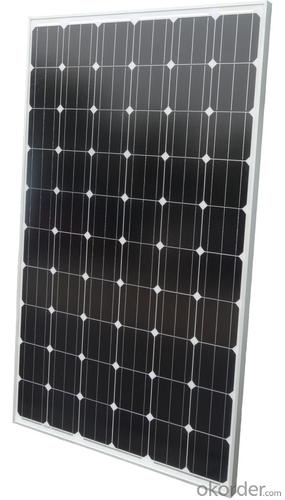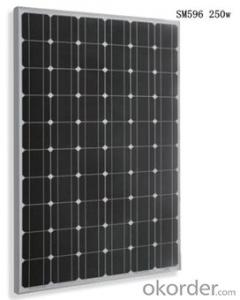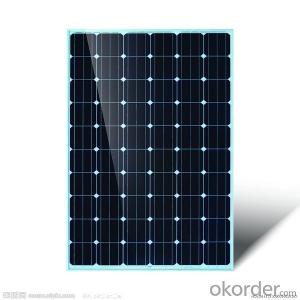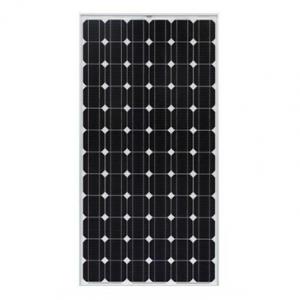12 Volt Monocrystalline Solar Module 250W
- Loading Port:
- China Main Port
- Payment Terms:
- TT OR LC
- Min Order Qty:
- -
- Supply Capability:
- -
OKorder Service Pledge
OKorder Financial Service
You Might Also Like
Solar Monocrystalline (210W-225W)
Introduction of Solar Monocrystalline (210W-225W)
Solar modules use light energy (photons) from the sun to generate electricity through the photovoltaic effect. The majority of modules use wafer-based crystalline silicon cells or thin-film cells based on cadmium telluride or silicon. The structural (load carrying) member of a module can either be the top layer or the back layer. Cells must also be protected from mechanical damage and moisture. Most solar modules are rigid, but semi-flexible ones are available, based on thin-film cells. These early solar modules were first used in space in 1958.
CNBM Solar photovoltaic (PV) Panel is designed for large electrical power requirements. It is the optimal choice for both on-grid and off-grid power systems. CNBM Solar panel offers high performance of power per square foot of solar array. Monocrystalline silicon(c-Si): often made using the Czochralski process. Single-crystal wafer cells tend to be expensive, and because they are cut from cylindrical ingots, do not completely cover a square solar cell module without a substantial waste of refined silicon. Hence most c-Si panels have uncovered gaps at the four corners of the cells.
Characteristics of Solar Monocrystalline (210W-225W)
I. Solar Cell : High efficiency crystalline solar cell. Even if under the weak light, the solar module can produce maximum power output.
II. Tempered glass (toughened glass): Anti-reflecting coating and high transmission rate glass increase the power output and mechanical strength of solar module.
III. EVA and TPT: Using high quality EVA and TPT to prevent destroying and water.
IV. AI frame: Without screw, corner connection. 6 holes on the frame can be installed easily.
V. Junction box: Multi function junction box with water proof.
VI. Long lifetime: ≥25 years; Less power decrease.
VII. Good performance of preventing from atrocious weather such as wind and hails.
VIII. Resisting moisture and etching effectively, not effected by geology.
IX. The certificate issued by international authority: UL, TUV, IEC, VDE, CE.
Standard Test Conditions of Solar Monocrystalline (210W-225W)
The opto-electrical specifications shown below are stabilized values being measured at Standard Test Conditions, Irradiance: 1000W/m2, Spectrum: AM1.5 at 25°C, The info below is subject to manufacturing tolerances. Where appropriate minutes of measurement are available and are used for the dimensioning of the installation.
Advantages of Solar Monocrystalline (210W-225W)
• CNBM Solar performance guarantees for 25 years
• 10 years guarantee for workmanship
• Timeliness of delivery
• Quality Products certified (TÜV, UL, CE, VDE, ISO)
CNBM International Corporation's products including Monocrystalline Solar Panel, Polycrystalline Solar Panel have received and enjoyed famous reputation in many countries and regions in the world .As a solar panel manufacturer in China, we strive to provide our customers with excellent service, superior products and unmatched value.
- Q: What is the principle of solar panels work?
- light - heat - electric conversion method through the use of solar radiation generated by thermal energy, usually by the solar collector will absorb the heat into the refrigerant refrigerant, and then drive the turbine power generation. The previous process is the light-heat conversion process; the latter process is the thermo-electrical conversion process.
- Q: who has solar panels on their home and are they worth it
- Of okorder
- Q: I had someone quote me for solar panels on my house but I can't afford it. They were talking about how I have enough room and the perfect location to put many of them and actually get paid for it. I have about a half acre that is tiered and points in the correct direction for them to get pretty much the full day sun. Additionally, I live in so cal where it is sunny most of the year. Does anyone know if solar companies will lease or install them to get the payback? I would be happy to allow them to use the land just to cover my electrical expense and they could have any payback.
- There okorder /... The article below gives some other creative ways to finance a PV system.
- Q: Do solar panels require a backup generator?
- No, solar panels do not require a backup generator. They generate electricity directly from sunlight and can store excess energy in batteries for use when the sun is not shining.
- Q: Can solar panels be installed on a factory or industrial facility?
- Yes, solar panels can be installed on a factory or industrial facility. In fact, many factories and industrial facilities are increasingly turning to solar power as a sustainable and cost-effective energy solution. Installing solar panels on such facilities can help reduce electricity bills, decrease reliance on fossil fuels, and contribute to a greener and more environmentally-friendly operation.
- Q: I have an inverter and a battery 20 Amperes.Daily sun shine approx. 7 Hours.Do I need to buy anything or should I connect the solar panel to the Battery direct?
- No, don't connect the panel directly to the battery. You need to isolate the solar panel charging output from the AC-powered charger. A couple of high-current diodes arranged with their anodes connected to the charging sources in the positive supply line will allow either the charger or the solar panel to lift the voltage high enough to charge the battery, albeit with about 0.6 volts dropped across the diode. Both cathode ends would be connected to the battery. This arrangement allows a positive current to flow from either or both charging sources at the same time, although in practice, one will generally be higher than the other. Also, if the AC charger's voltage is significantly higher than the solar panel, the charger may always charge the battery. You would need to regulate its output to be slightly lower than the solar panel when it's near it's minimum useful operating voltage. (note that the 0.6 forward bias voltage on the diode might prevent the solar panel from completely charging the battery if it has any voltage regulation on its output)
- Q: Why are they placed there? How come they aren't placed on the floor or window.My fiance and I are interested in putting solar panels on our new home. I was really curious and google wasn't giving me the answer. My roof is pretty small in our new house and I don't think it would fit there. Why is it usually placed there and is there another place? You will be chosen as best answer if you answer all my questions. Thanks in advance, and I would appreciate if nobody is rude. Otherwise, I will have to report abuse.
- In most cases the roof gets the most exposure to the sun. However Panels can be mounted in the yard on platforms that follows the Sun's movement. One must take into consideration of where the panels will get the most exposure to the sun.
- Q: Can solar panels power an entire house?
- Yes, solar panels can power an entire house. By installing a sufficient number of solar panels and utilizing a battery storage system, it is possible to generate and store enough solar energy to power all the electrical needs of a house. However, the size of the solar panel system required depends on various factors such as the energy consumption of the house, geographic location, and available sunlight.
- Q: Can solar panels be installed on boats or RVs?
- Yes, solar panels can be installed on boats or RVs. In fact, solar panels are a popular choice for both boats and RVs as they provide a sustainable and reliable source of electricity while on the move.
- Q: Are solar panels expensive?
- Solar panels can be expensive upfront, but they are a long-term investment that can save money on electricity bills in the future. The cost of solar panels has decreased significantly in recent years, making them more affordable for many homeowners and businesses. Additionally, there are various financing options available that can help make solar panels more accessible to a wider range of people.
Send your message to us
12 Volt Monocrystalline Solar Module 250W
- Loading Port:
- China Main Port
- Payment Terms:
- TT OR LC
- Min Order Qty:
- -
- Supply Capability:
- -
OKorder Service Pledge
OKorder Financial Service
Similar products
Hot products
Hot Searches
Related keywords
























